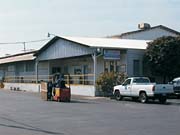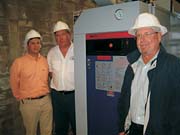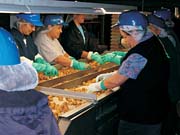Though the check from Pacific Gas & Electric took a few months to arrive, it put a smile on the face of Michael Emigh (pronounced Amy). Not only did he "give a fig" about $16,000, it rewarded the fig growers of California for being more friendly to the environment, while they increased their profit margins (by cutting production costs), and it meant that Roy Ziegenfuss could let someone sleep an extra four hours on Monday mornings.
The PG&E program that generated the check was directly related to energy efficiency and air pollution. California is the country's test case for these problems. When California finds a system that increases efficiency and lessens emissions, other states are sure to take notice. Some people think they almost solved their problem by trying to drive industry out of the state with high energy prices. But it didn't work. Those prices are dropping, and some industries really want to be in California. Especially fig processing, as it needs to be where the figs are.
So when Emigh heard about the PG&E rebate program, it made his decision to get rid of his company's old firetube boiler a lot easier.
Emigh is the president of Valley Fig Growers, a grower-owned marketing cooperative in Fresno, CA. It processes, markets and sells dried figs.
Valley Fig was formed in 1959, so it has had a lot of experience with the boilers it depends on. Steam from its boilers is used two ways: First, to run what looks like a large pressure cooker for steam processing the figs to rehydrate them from their natural state--about 15% moisture--up to around 30% moisture. Secondly, steam is used to extract the juice from the rehydrated figs to make fig concentrate.

Figs...Packaged, Powdered, Extruded or Extracted
This is not a small operation. They have a cold storage building that holds about 8,000 tons of figs--always at the ready for processing and packaging. These are Valley Fig's raw material--dried figs.
According to Emigh, "We have about 35 members in the cooperative, now. We handle over half, almost 60%, of the California fig industry's tonnage. We're kind of like a sausage factory. We utilize everything that there is in the fig. We package whole figs under our own brand, Blue Ribbon Orchard Choice, for retail sales. We also sell under the Sun Maid brand. You can find us in 82% of the grocery stores across the United States. We make fig paste, which is essentially figs that are ground up in what looks like a hamburger grinder. The paste goes to the biggest fig bar manufacturer, Nabisco, for Fig Newtons, as well as to other companies that make private label fig bars. And, of course, we also make fig concentrate, which is an extracted, concentrated juice of the fig. It is used in the baking industry and tobacco industry as a flavoring agent. We also dice figs, extrude figs, and we can make colored and flavored fig pieces that taste like any fruit that you want. They are a very good carrier of flavors and colors. So, we can disguise a fig as a blueberry, for example. We also make fig powder, which is used in some supplement tablets for calcium and fiber. There are five grams of fiber in a quarter-cup serving, which is 20% of your daily requirement. The fig is high in calcium, fiber and potassium. It is a good source of nutrients."

We Need Steam...The Government Wants It Clean
The firetube boiler problem was brought to a head by California's strict limitations on the amount of oxides of nitrogen (NOx) that a gas-fired boiler can emit. Even though Valley Fig Growers replaced the boiler's burner several years ago with a state-of-the-art burner, at full capacity, it still emitted too much NOx.Roy Ziegenfuss, Valley Fig Growers' maintenance superintendent, explained the problems presented by their old 300 BBHP firetube boiler. "We would have had plenty of capacity if we could have used the boiler's full potential, but then we would have been in violation of the local smog laws. Here in California, we have very strict smog emission standards. To be able to meet the smog emission restrictions, we had to derate the boiler down so much that we weren't able to get 300 BHP. Derating is like adjusting the carburetor on your car. You lower the air and you lower the gas. You sit there and let it run for a while, and then measure the gas emissions. It is kind of trial and error. You just keep adjusting it and adjusting it until you get the most energy you can out of it, while maintaining acceptable emissions. After derating the firetube boiler, the tests we ran showed that we were getting around 175 BHP out of it. So that kind of hurt us. There were times when we had to run everything in the plant, and we had a hard time maintaining proper steam pressure."
Another problem was how long it took the firetube boiler to heat up. The boiler was in use 24 hours a day, five days a week. The shutdown on the weekends allowed it to cool off. Somebody would have to come in at 2 a.m. on Monday morning to start it, so that it would be ready when the workforce arrived at 6 a.m. That's how long it would take to produce steam from the firetube's 900 gallons of water.

Prime (Engineering) Pays
Emigh recalled the encounter that resulted in a solution to Valley Fig Growers' problems. "At that point, we ran across Nate Moehlman of Moehlman Boilers. He suggested that we look at the Miura. We found that we could replace our large firetube boiler with two 100 BHP Miuras."Russ Binder of Miura's California office suggested they apply for a rebate offered by PG&E on qualifying fuel efficient boilers. According to Binder, "PG&E looked at the efficiency ratings in our brochures and approved the rebate for the project. Valley Fig went ahead with it, put it all in and had the gas company come back. The gas company certified that everything proposed had been done, and hand-delivered what amounted to an up-front reward ($16,000) for being fuel efficient."
As it stands now, if a boiler is under a 119 BHP rating, California's San Joaquin Air Pollution Control District doesn't require that it be tested every year. But, the state legislature is trying to change that, since many companies are replacing large boilers with three or four smaller ones. They are talking about requiring that the total onsite horsepower be tested. According to Ziegenfuss, "We're not worried about that because the Miuras are still so much more efficient than what we had that we would still pass. It would just be a matter of having the state come in and do the testing--which we would have to pay for, of course." He added, "We have had them tested at both low fire and high fire. At high fire, the emissions from both of them were less than the firetube 300 BHP boiler at its derated 175 BHP. They were way less than the firetube boiler was at the best that it could be."
Getting All Fired Up On Mondays
No more middle of the night treks to fire up the boiler for the work week. Ziegenfuss reported that "from dead cold, we can have 125 psi of steam in 8-10 minutes. If we were to valve off the boiler, it could heat itself up and be to temperature in about five minutes. But we're heating up the boiler and pressurizing our whole plant all at the same time, and it still does it in under 10 minutes."Why It Works
Mark Utzinger of Miura's North American headquarters outside Chicago, explained how Miura engineers lowered the NOx emissions. "Miura uses the pre-mix method of NOx control. Pre-mix burners combine gas and air in a manifold. They are burned through a flat burner that has lots of little holes in it. This reduces flame temperature, which reduces NOx. This pre-mix method can achieve NOx levels under 20 ppm, and on some models, less than 12 ppm. The most stringent requirements in California, for boilers in this size range, limit emissions to 12 ppm. Miura developed the low NOx pre-mix burner and boiler design to lower the peak flame temperature--lowering NOx."Miura's LX model has published results that show a value of 85.7% efficiency. Miura's compact forced-flow, vertical-tube pressure vessel design is more efficient, requires less heating surface, achieves higher efficiency and is less than half the size of firetube and other conventional boilers.
A reduction in water volume was accomplished by reducing the size of the upper and lower headers, eliminating water from the upper header, and partially eliminating water from the tubes by having a two-phase mixture of steam and water in the tubes. This design incorporates a floating header that all but eliminates thermal shock. The result is a small, compact boiler which can be turned on and off quickly and efficiently. This reduces original water usage by 95%. That means that during start-up, the boiler heats up 60 gallons of water, as opposed to the old firetube's 900 gallons.
Two Are Better Than One
Of course, this low water content allows for fast start-up. This in combination with a step-fired burner makes it easy to tie boilers in a multiple installation so they act like one large boiler. When load swings occur, boilers can be brought on and off line like a light switch, eliminating nonproductive steam generation.According to Ziegenfuss, "The way our Miura boilers are set up, one boiler is adjusted slightly lower than the other, so if they did get to a point where they didn't need one of the boilers, one boiler shuts down, and the plant runs on just one. Then, if the demand comes up, it automatically fires up again."
Emigh noted, "We found that we are running more efficiently, our exhaust gases meet the state requirements, and to date, it looks like we are saving 8-10% on our gas bills." And, no one has to come in at 2 a.m. Monday mornings.
For more information on Miura boilers, visit Miura Boiler Inc. at www.miuraboiler.com.